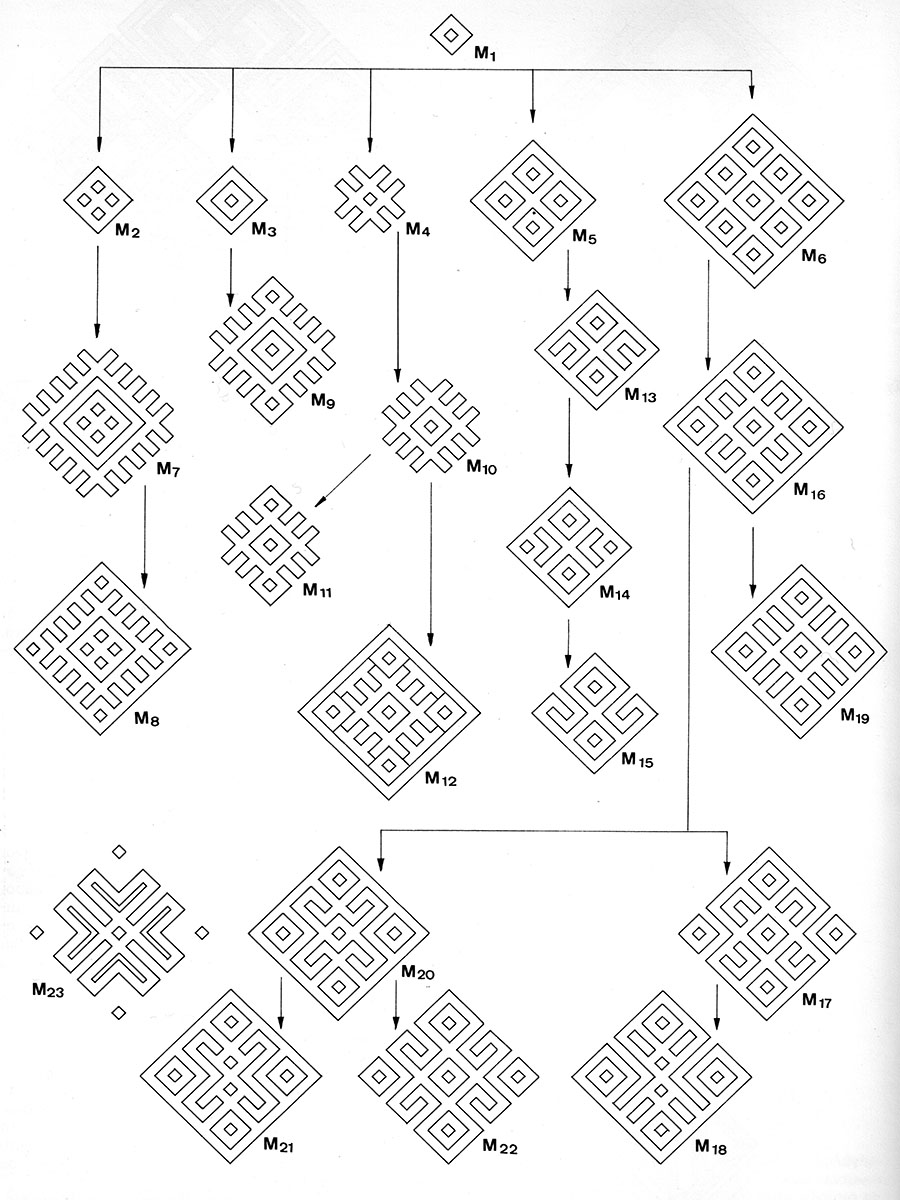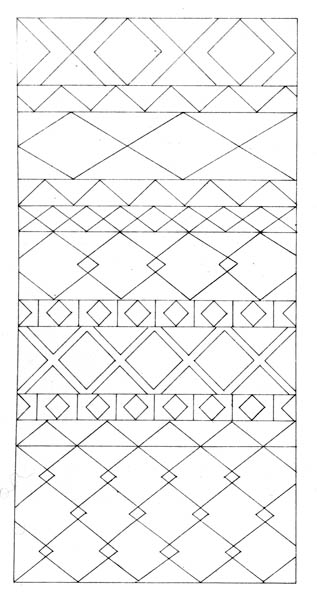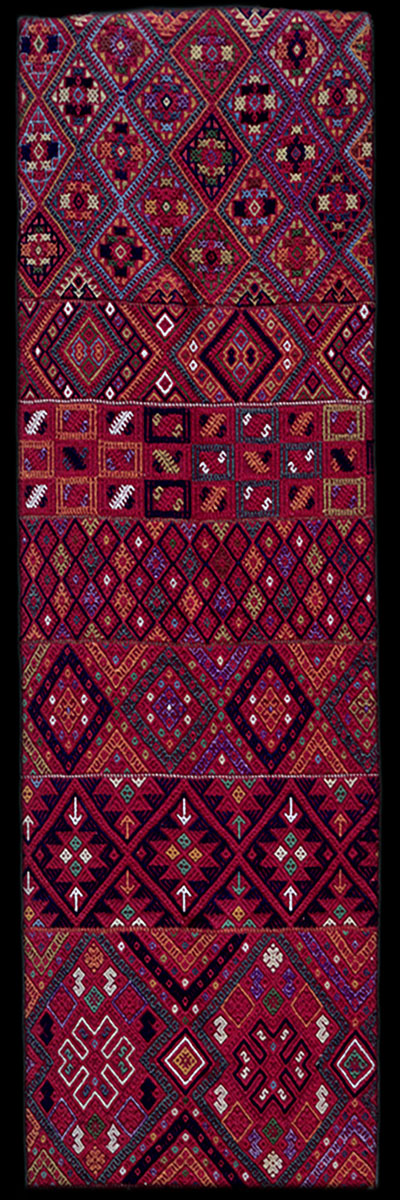Textiles
Cretan Textiles
Analytical Discussion Of Motifs
Although the analytical discussion and systematic presentation of motifs, moving from simpler to more complex forms, does not correspond to the natural evolution and development of the forms by weavers, it helps us to understand the basic features and guiding principles of geometrical pattern weaves.
Each motif has a characteristic basic structure and secondary decorative themes or filling motifs. The basic structure consists of the main lines of the pattern, which define the motif and divide it into smaller areas.
The empty spaces in the basic structure are filled with the secondary decorative themes.
Basic Structure Of The Motifs
Filling Motifs
The filling motifs used in xobliasta woven fabrics are always abstract geometrical shapes. These are placed in the secondary spaces of the basic structure of the main motif, which are usually diamond-shaped. In order to fit into this outline, most motifs are also rhomboid.
They may be large or small, depending on the spaces left by the main motif, or even tiny, when even the smallest spaces are filled. In some cases the main motif may be so dense and complicated that hardly any room, or even none at all, is left for secondary decorative motifs.

Relationships Between Filling Motifs
In every form of folk art, once a motif has become part of tradition it never remains static but changes and develops, giving rise to a multitude of variations over time.
Most of the filling motifs used in xobliasta woven fabrics are clearly related, allowing us to discover, describe and analyse these relationships.
All decorative motifs, from the simplest to the most complex, and even the few that seem to have arisen from an independent and original conception, are governed by the same spirit and style, and faithfully follow certain general principles:
symmetry along the horizontal axis
“lines” running in two oblique directions at right angles to each other
placement of the theme in a diamond-shaped frame
monochrome, uniform surface restricted to the minimum
Bands: Analytical Discussion
In every band the same motif is always repeated.
In Cretan woven fabrics with geometrical decoration we never find two different motifs alternating in the same band, even when the motifs are similar in basic shape and size.
The size of the motif determines the width of the band: when the motif is large, the band is wider and contains fewer motifs. When the motif is small, on the other hand, there are more motifs in narrower bands.
Each decorative band has a beginning and an end: its two long sides are defined either by lines, either by very narrow bands with simple motifs. These bands are called “secondary” or “complementary”, because – at least in older woven fabrics – they are not used for the exclusive decoration of the fabric but always accompany the wider, main bands, usually bordering the latter on either side.
Within their limits, the bands are symmetrical along the horizontal axis passing through them widthwise.
Bands with koubedes, found in the koubelidika woven fabrics of Central Crete, are an exception to this rule.
Usually a band is finished with a complete motif. In some cases, however, the same motif is repeated in a second or even a third row, each interlocking with the previous one, giving the impression of an oblique (diagonal) pattern of motifs within the band.
There are no “empty” monochrome, undecorated surfaces within the band or motif.
The (usually triangular) areas of the band not covered by the main motif are filled with decorative elements known following categories:
* Half or part of the main band motif
* Half or part of a different motifas “supplementary” motifs.
Supplementary motifs fall into the following categories:
* Half or part of the main band motif
* Half or part of a different motif
Surface Pattern
In soyioma woven fabrics, the relationship between the respective widths of the decorative bands and the way in which they define the surface of the woven fabric are of particular interest and great variety.
In the simplest example, there is a steady alternation of two zones of very different width; in this case, the narrow secondary bands separate the wider ones and make them stand out. Often the secondary bands are more and narrower, accentuating the horizontal lines.
At the opposite end of the scale to the above example, in which the same pattern applies to the entire surface of the woven fabric, is the case where the bands at either end are appreciably wider and therefore more elaborately decorated than those in the centre.
The particular relationship between the decorative bands is one of the unique features of each woven fabric, differentiating it from other, similar works.
Motifs
In soyioma woven fabrics, both wide and narrow decorative bands contain regular geometrical motifs, mainly composed of oblique lines (diamond shapes). As a rule, it is the size of the motif that determines the width and pattern of each band.
In the narrow bands the motifs are smaller and more frequent along the length of the band. The rhythm is dense and rapid, as opposed to that of the wide bands, where the motifs are more widely spaced.

The surface of the woven fabric presents not only a sequence of bands but also a composition of rhythms and density in both pattern and colour.
However, wide bands are not always the result of choosing a particular motif. In soyioma woven fabrics we often find wide decorative bands formed by the repetition of the same small motif in every direction; in this case the width of the band is determined by the weaver.

Colours
The colours used in soyioma woven fabrics are red, green, deep yellow, ochre, violet-blue and black. The vast majority of these woven fabrics are reddish; red is the dominant colour and is often used for the ground. Other ground colours are deep yellow, ochre and green. The ground weave is usually the same colour throughout.
In Cretan soyioma woven fabrics, as with other large Cretan woven fabrics with geometrical motifs arranged in bands, one band usually contains the full range of colours.
The way in which the weaver chooses to use each colour – i.e. for which motifs – plays as important a part in the final look of the woven fabric, as the choice of motif and composition of the decorative bands.
Composition
Just as a decorative band is complete as to pattern and colour, we observe that each larger area of the woven fabric containing several bands also constitutes a separate composition, aesthetically complete in itself.
However, it is extremely rare for any two decorative areas from different woven fabrics to match and be used to make a single length of fabric.

Kilimi, Kenourio 1910
Even if such a “composition” obeyed the rules of decorative composition of soyioma woven fabrics, it would have to be made using the same colour range, the same warp and weft threads and, most importantly, by the same weaver with the same personality and artistic sensibility.
Often two areas of the same woven fabric may be so different that, if they are seen separately, it is hard to imagine they come from the same fabric. However the final result is so complete, structured and harmonious that one is filled with admiration for the weaver’s skill and audacity.

Makathi, Kalyviani Monastery
Surface Pattern
There are two different types of surface in this category of woven fabric: the complicated surfaces at either end, with bands of decorative motifs, and the central section with its horizontal stripes.
The decorative bands at either end alternate in the same way as on soyioma woven fabrics: they are separated by very thin stripes, a few millimetres in width. The bands in the central section of these woven fabrics, however, are often up to three centimetres wide.
The colours of the bands are the same as those of the geometrical motifs. The uninterrupted way in which they are used makes them stand out more strongly and clearly, emphasising their differences in hue.
The stripes in the central zone are arranged regularly and grouped together in such a way as to constitute a wider, perfectly symmetrical band, taken either separately or together with the narrow decorative band they frame.
These complex bands in the central part of the woven fabric alternate regularly, forming a rhythm that is either rapid and dense or slower and quieter, depending on the width of the band.
The repeated rhythm of the complex bands in the central area becomes more apparent when they are separated by black and white stripes, as is often the case in woven fabrics of this type.
Composition
Ultimately, the most interesting of all is the overall visual impression produced by the juxtaposition of surfaces in different styles: what are the elements that unify and draw these into a single woven surface of perfectly harmonized pattern and colour?
A primary element unifying the whole surface is the common colour scheme.
A second element, no less important, is the bands in the central section with decorative motifs which are smaller than but related to the motifs on the ends.
In woven fabrics of this type, elements of design and colour from the ends enter the central surface of the woven fabric. The complex and dense weaving pattern of the ends is simplified and spaced out in the centre, as stripes of the same colour are interposed between the decorative bands at regular intervals. In this way they interrupt the continuity of the bands and isolate them, with the result that the complex pattern of the ends is broken down in the centre.
Differences Between The Woven Fabrics Of Lassithi And Heraklion
There are two important difference between the woven fabrics of the Lassithi district and those of other districts:
In woven fabrics from other districts, the number of decorative bands at the ends varies between two and six, and they are rarely arranged symmetrically.
In woven fabrics from other districts, on the contrary, this area is covered with groups of same-coloured stripes, and any decorative bands are narrow with small, simple decorative motifs. Here, the elements from the ends found in the central area are purely chromatic.
Decoration: Bands
As with soyioma woven fabrics, the decorative surface consists of bands of geometrical motifs. Often there are three decorative bands: the central one is wider and has larger and more complex motifs, while the other two are narrower, with smaller and simpler motifs. In many cases there are more than three bands, and sometimes only two.
Figurative Motifs
Apart from the “classic” decorative bands, which are always limited by horizontal wefts, woven fabrics with decorated ends usually have a band of abstract, schematic figurative motifs. These motifs are placed on the side of the ground weave and generally depict small human figures, birds or flowers. The last continuous line of the decorated surface may be said to symbolize the earth, and is reminiscent of children’s drawings in which people, animals, trees and flowers are set on a line dividing the earth from the sky.
Each decorated end of the woven fabric is double: one side faces inwards to the ground, while the other faces outwards to the end of the material, finished with the characteristic Cretan lace “dessa”.
The figurative motifs are much less densely designed and woven than the geometrical patterns. They are woven into the ground – or the ground enters between the motifs – resulting in a smooth transition from the decorated to the undecorated surface.
Ground Motifs
In a few cases, woven fabrics may have small motifs scattered on the ground (kambos) as coloured elements or allusions.
These motifs break up the uniformity of the surface and transform it from passive and static to moving, linking the two fields of colour and passing the colours of one into the other.
In the kilimi from Ierapetra, the small motifs embroidered on the ground weave look like coloured snowflakes, some floating in the air while others have settled and formed a layer of multicoloured snow, the surface with the decorative motifs.
One characteristic of large woven fabrics with decorated ends is that the ground is almost always white, with a few exceptions when it may be yellow, orange or green but never red.
The Two Ends
The decoration at either end of a piece of fabric is not the same. Often it is not even equal; one end has more bands and more complex motifs than the other, secondary end. This is due to the fact that these textiles are placed so that one end shows more and is set off.
Both ends of a woven fabric are decorated in a similar manner. In many cases the decoration of the secondary end is derived from that of the primary one, with the removal of bands, narrowing of a band, simplification of decorative motifs etc.
The main motif of the wide decorated surface, the full repeated diamond, constitutes the central band of the secondary end. The patterns within and between the motifs are abstract and simplified, while the figurative motifs connecting the decorated to the monochrome surface become smaller and simpler at the less decorated end of the textile, in order to adapt to its scale.
Both ends of the fabric are in the same style, even when the motifs are dissimilar. This is due to the common underlying colours, the use of the same colours in the same proportions, and the common colours and density of the motifs.
The Koubes Motif
Several variations of the koubes (cupola) are found in Cretan woven fabrics, with different proportions in the lines, but always retaining the same basic characteristics.
The lower part of the koubes outline is composed of two vertical lines which become oblique from a certain point and begin to converge. Before they can meet, the lines become vertical again, forming a “neck” ending in a diamond.
There is almost always a second, inner outline in the shape of a pointed roof.
Surface Pattern
The surface pattern of koubelidika woven fabrics, which are usually composed of two or three panels, presents an extraordinary variety.
The koubedes decorate either only one end of the woven fabric – in which case the rest of the surface is covered with geometrical motifs – or both, along a horizontal axis of symmetry running through the centre of the weave. In the latter case, the central section of the woven fabric between the points of the opposed koubedes is decorated with bands of geometrical motifs or simple stripes, or it may sometimes remain empty.
Unique Decorative Features Of Koubelidika Kilimia
Koubelidika kilimia present certain unique decorative features, specifically in the filling of the area created by the basic lines of the main motif, the koubes.
As with all Cretan weaving with geometrical decoration, in koubelidika the decorated surfaces of the woven fabric are filled with designs, leaving only a very small area of monochrome ground weave showing.
The unique shapes of the koubedes themselves and the areas between them are always filled in the same way in woven fabrics of this type:
* with decorative bands of simple motifs at right angles to the direction of weaving, and
* with various compositions of the same motif, created by repeating it in every direction.
Group 1
The surface of the woven fabrics in this group is divided into relatively narrow bands, some monochrome and others decorated with simple motifs.
Each band seems to be composed of a row of identically-shaped pieces in different colours. The simplicity of the pattern encourages the use of bright, clear colours, daringly and imaginatively juxtaposed.
Group 2
From the point of view of pattern design, the surface of these woven fabrics is divided into bands of graduated widths. The smaller motifs (in the narrow bands) are simply fragments of the large, complex motif. This results in many graduated, similar surfaces. The motifs on these surfaces would form rectangles, if their sides at right angles to the weave had not been replaced by zigzag lines. These crooked lines with acute angles are repeated rhythmically, giving an impression of movement to the surface of the woven fabric.
Group 3
The special feature of this group of woven fabrics is that the geometrical patterns are composed of many small motifs which could be called “unitary”. In these woven fabrics, the lines separating two different colours are such that the motifs they isolate are identical in shape.
The colours are placed within this web of lines on the design surface, forming a second, larger-scale pattern. In effect, it is the colours that define the geometrical motifs in this group of woven fabrics, as they are used with rigid regularity and play a primary role.
